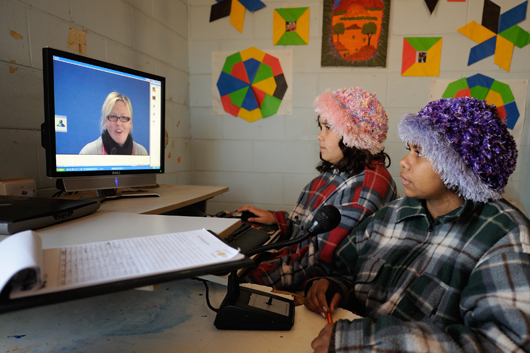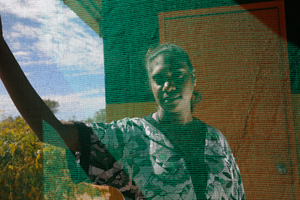A.bc
In Australia, sulle tracce di Chatwin 20 anni dopo Le Vie dei Canti
Palazzo delle Esposizioni, Roma
A.bc
In Australia, in Chatwin's footsteps 20 years after The Songlines Palazzo
Delle Esposizioni, Rome


Fuori
un cartello annuncia che è una “healthy and clean”
community. Tutto sembra armonioso, lindo. In mezzo a un deserto punteggiato
di spinifex, arbusti e piccoli alberi, abitato da cavalli selvaggi, canguri,
mucche. Tre case basse disposte a circolo, la scuola, un orto con le patate
del bush, pomodori, lattughe, mango, piante medicinali protette da una
rete frangivento e nutrite da un piccolo sistema di irrigazione. Dentro
la scuola, una sala con tre banchi individuali e una lavagna attorniata
da cartelli multicolori. Un’altra sala ospita il computer e la postazione
interattiva da cui le alunne possono seguire direttamente le lezioni di
un’insegnante di Alice Springs, lontana 300 chilometri a est. Sono
cambiate molte cose da quando nel 1944 Miss Adelaide Miethke ebbe l’idea
di usare la radio per l’istruzione dei bambini dispersi nelle fattorie
dell’outback. La School of Air ormai si fa col computer non più
con la radio. Shannon e Kyra, sorellastre, 12 e 11 anni, affrontano un
test di aritmetica con l’uso di un software in grado di stabilire
l’esattezza della risposta e misurare i tempi di reazione delle
risposte. Il tutor-maestro-tuttofare è Rob, 54 anni, originario
dell’Oregon, vissuto a lungo in California, e poi - arruolatosi
nell’Esercito – in Germania e Alaska. Ad un certo punto, volevano
metterlo dietro a una scrivania, ma ha preferito lasciare la carriera
militare. Si è rimesso a studiare e si è laureato. Poi è
venuto in Australia e ad Adelaide si è specializzato in studi aborigeni.
Qualcuno gli ha segnalato che a Town Bore cercavano un maestro ed è
qui da quattro anni. Mina è la terza alunna, 17 anni, figlia di
un aborigeno del Top End e di una aborigena del Red Centre, che ora sono
lontani. Anche lei, dice, «si sente un mix etnico». Parla
del suo Sogno, dei suoi totem e mostra il quadro che ha dipinto e li rappresenta.
Uova di formica del miele, il delfino, lo squalo, il serpente. È
qui per «avere un’istruzione, diventare più aperta».
Stanno per partire, tutti e quattro. Hanno vinto una borsa di studio della
School of Air e useranno quei soldi per un viaggio verso nord. Vogliono
vedere il mare
Town Bore. Mina, 17 anni, una delle tre allieve della scuola della comunità
Town Bore. Mina, 17 anni, una delle tre allieve della scuola della comunità
A
notice says that it is a «healthy and clean community». Everything
seems to be harmonious and neat. In the middle of a desert dotted with
spinifexes, shrubs and little trees, inhabited by wild horses, kangaroos
and cows. Three low houses in a circle, the school, a vegetable garden
with bush potatoes, tomatoes, lettuce, mangoes, medicinal herbs protected
by a windbreak net and watered by a small irrigation system. Inside the
school, a room with three desks and a blackboard surrounded by multicolour
posters. In another room there is a computer and an interactive position
from where the pupils can follow directly the lessons of a teacher in
Alice Spring, 300 kilometres away, to the east. Many things have changed
since 1944 when Miss Adelaide Miethke had the idea of using the radio
to teach the children scattered in the outback farms. The School of Air
works by computer now, no longer by radio. Shannon and Kyra, stepsisters
of 12 and 11, take a maths test using software which can assess the correctness
of the answers and measure their reaction time. The tutor-teacher-factotum
is Rob, 54, from Oregon. He lived in California and then - after joining
the Army- in Germany and Alaska. Once they offered him a desk job, but
he chose to leave the military career. He went back to study and graduated.
Then he came to Australia and specialized in Aboriginal Studies in Adelaide.
Someone told him they were looking for a primary school teacher in Town
Bore, and he has been here for four years now. Mina, 17, is the third
pupil. Her father is an Aborigine from the Top End, her mother from the
Red Centre, and now they are both far away. She too «feels an ethnic
mix», she says. She talks about her Dream, her totems and shows
the picture representing them which she has painted. Eggs of the honey
ants, a dolphin, a shark, a snake. She is here to «get her education,
to become more broadminded». They are all going to leave soon, the
four of them. They have been granted a scholarship by the School of Air
and they are going to use the money to travel northwards. They want to
see the sea
Town Bore. Mina, 17, one of the three pupils of the community school
Town Bore. Mina, 17, one of the three pupils of the community school
